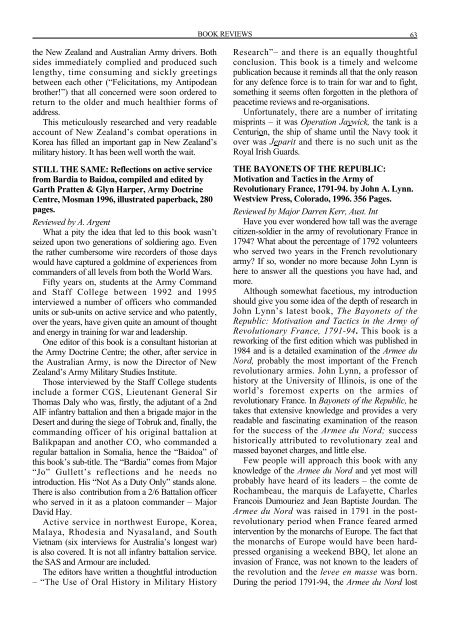ISSUE 125 : Jul/Aug - 1997 - Australian Defence Force Journal
ISSUE 125 : Jul/Aug - 1997 - Australian Defence Force Journal
ISSUE 125 : Jul/Aug - 1997 - Australian Defence Force Journal
You also want an ePaper? Increase the reach of your titles
YUMPU automatically turns print PDFs into web optimized ePapers that Google loves.
BOOK REVIEWS63the New Zealand and <strong>Australian</strong> Army drivers. Bothsides immediately complied and produced suchlengthy, time consuming and sickly greetingsbetween each other (“Felicitations, my Antipodeanbrother!”) that all concerned were soon ordered toreturn to the older and much healthier forms ofaddress.This meticulously researched and very readableaccount of New Zealand’s combat operations inKorea has filled an important gap in New Zealand’smilitary history. It has been well worth the wait.STILL THE SAME: Reflections on active servicefrom Bardia to Baidoa, compiled and edited byGarth Pratten & Glyn Harper, Army DoctrineCentre, Mosman 1996, illustrated paperback, 280pages.Reviewed by A. ArgentWhat a pity the idea that led to this book wasn’tseized upon two generations of soldiering ago. Eventhe rather cumbersome wire recorders of those dayswould have captured a goldmine of experiences fromcommanders of all levels from both the World Wars.Fifty years on, students at the Army Commandand Staff College between 1992 and 1995interviewed a number of officers who commandedunits or sub-units on active service and who patently,over the years, have given quite an amount of thoughtand energy in training for war and leadership.One editor of this book is a consultant historian atthe Army Doctrine Centre; the other, after service inthe <strong>Australian</strong> Army, is now the Director of NewZealand’s Army Military Studies Institute.Those interviewed by the Staff College studentsinclude a former CGS, Lieutenant General SirThomas Daly who was, firstly, the adjutant of a 2ndAIF infantry battalion and then a brigade major in theDesert and during the siege of Tobruk and, finally, thecommanding officer of his original battalion atBalikpapan and another CO, who commanded aregular battalion in Somalia, hence the “Baidoa” ofthis book’s sub-title. The “Bardia” comes from Major“Jo” Gullett’s reflections and he needs nointroduction. His “Not As a Duty Only” stands alone.There is also contribution from a 2/6 Battalion officerwho served in it as a platoon commander – MajorDavid Hay.Active service in northwest Europe, Korea,Malaya, Rhodesia and Nyasaland, and SouthVietnam (six interviews for Australia’s longest war)is also covered. It is not all infantry battalion service.the SAS and Armour are included.The editors have written a thoughtful introduction– “The Use of Oral History in Military HistoryResearch”– and there is an equally thoughtfulconclusion. This book is a timely and welcomepublication because it reminds all that the only reasonfor any defence force is to train for war and to fight,something it seems often forgotten in the plethora ofpeacetime reviews and re-organisations.Unfortunately, there are a number of irritatingmisprints – it was Operation Jaywick, the tank is aCenturion, the ship of shame until the Navy took itover was Jeparit and there is no such unit as theRoyal Irish Guards.THE BAYONETS OF THE REPUBLIC:Motivation and Tactics in the Army ofRevolutionary France, 1791-94. by John A. Lynn.Westview Press, Colorado, 1996. 356 Pages.Reviewed by Major Darren Kerr, Aust. IntHave you ever wondered how tall was the averagecitizen-soldier in the army of revolutionary France in1794? What about the percentage of 1792 volunteerswho served two years in the French revolutionaryarmy? If so, wonder no more because John Lynn ishere to answer all the questions you have had, andmore.Although somewhat facetious, my introductionshould give you some idea of the depth of research inJohn Lynn’s latest book, The Bayonets of theRepublic: Motivation and Tactics in the Army ofRevolutionary France, 1791-94. This book is areworking of the first edition which was published in1984 and is a detailed examination of the Armee duNord, probably the most important of the Frenchrevolutionary armies. John Lynn, a professor ofhistory at the University of Illinois, is one of theworld’s foremost experts on the armies ofrevolutionary France. In Bayonets of the Republic, hetakes that extensive knowledge and provides a veryreadable and fascinating examination of the reasonfor the success of the Armee du Nord; successhistorically attributed to revolutionary zeal andmassed bayonet charges, and little else.Few people will approach this book with anyknowledge of the Armee du Nord and yet most willprobably have heard of its leaders – the comte deRochambeau, the marquis de Lafayette, CharlesFrancois Dumouriez and Jean Baptiste Jourdan. TheArmee du Nord was raised in 1791 in the postrevolutionaryperiod when France feared armedintervention by the monarchs of Europe. The fact thatthe monarchs of Europe would have been hardpressedorganising a weekend BBQ, let alone aninvasion of France, was not known to the leaders ofthe revolution and the levee en masse was born.During the period 1791-94, the Armee du Nord lost
















